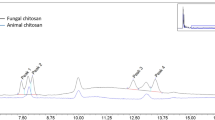Abstract
The effect of chitosan on Saccharomyces cerevisiae (the yeast that carries out alcohol fermentation), Brettanomyces bruxellensis and Brettanomyces intermedius (contaminants of alcohol fermentations), was investigated. The effect of chitosan was tested on each yeast, as well as on mixed cultivations of S. cerevisiae + B. bruxellensis and S. cerevisiae + B. intermedius. Chitosan enhanced the lag period of both strains of Brettanomyces (80 h for B. bruxellensis and 170 h for B. intermedius with 6 and 2 g/l chitosan, respectively). The growth rate of S. cerevisiae was inversely proportional to the chitosan concentration; the former was 50% when 6 g/l polysaccharide was used. Moreover, in mixed cultivations of S. cerevisiae and Brettanomyces strains, it was found that both B. bruxellensis and B. intermedius failed to grow while growth of S. cerevisiae was not affected (using 3 and 6 g/l chitosan, respectively). An interesting collateral result was that the presence of chitosan accelerated the consumption of glucose in the mixed cultivations (60 h instead of 120 h).



Similar content being viewed by others
References
Allan C, Hadwiger L (1979) The fungicidal effect of chitosan on fungi of varying cell wall composition. Exp Mycol 3:285–287
Bonora A, Mares D (1982) A simple colorimetric method for detecting cell viability in cultures of eucaryotic microorganisms. Curr Microbiol 7:217–222
Chatonnet P, Dubourdieu D, Boidron JN, Pons M (1992). The origin of ethylphenols in wines. J Sci Food Agric 60:165–178
Chatonnet P, Dubourdieu D, Boidron JN (1995) The influence of BrettanomyceslDekkera sp. yeasts and lactic acid bacteria on ethylphenol content of red wines. Am J Enol Vitic 46:463–468
Délia ML, Phowchinda O, Alfenore S, Strehaiano P (1997) Brettanomyces as a polluting yeast in alcoholic fermentations: study of its relation to Saccharomyces. In: Proceedings of 18th International Specialized Symposium on Yeast, 24–29 August 1997. Bled, Slovenia
Délia-Dupuy ML, de Miniac M, Phowchinda O, Strehaiano P (1995) Contamination par les levures Brettanomyces dans les fermentations alcooliques. Microbiol Aliment Nutr 13:349–359
De Miniac M (1989) Contamination des fermentations alcooliques industrielles par les levures du genre: Brettanomyces. Ind Aliment Agric 7–8:559–563
Froudière I, Larue F (1990) Conditions de survie de Brettanomyces (Dekkera) dans le moût de raisin et le vin. In: Ribereau-Gayon P, Lonvaud A (eds) Actualités oenologiques 89. Dunod, Paris, pp 297–303
Heresztyn T (1986) Formation of substituted tetrahydropyridines by species of Brettanomyces and Lactobacillus isolated from mousy wines. Am J Enol Vitic 3782:127–132
Lange H, Bavouzet JM, Taillander P, Delorme C (1993) Systematic error and comparison of four methods for assessing the viability of Saccharomyces cerevisiae suspensions. Biotechnol Tech 7:223–228
Larue F, Rozes N, Froudière I, Couty C, Ferreira GP (1991). Incidence du développement de Dekkera/Brettanomyces dans les moûts et les vins. J Int Sci Vigne Vin 25:149–165
Miller GL (1959) Use of dinitrosalicylic acid reagent for determination of reducing sugar. Anal Chem 31:426–428
Ohtakara A, Izume M, Mitsutomi M (1988) Action of microbial chitinases on chitosan with different degrees of deacetylation. Agric Biol Chem 52:3181–3182
Roller S, Covill N (1999) The antifungal properties of chitosan in laboratory media and apple juice. Int Food Microbiol 47:67–77
Roller S, Covill N (2000) The antimicrobial properties of chitosan in mayonnaise and mayonnaise-based shrimp salads. J Food Prot 63:202–209
Scheffers WA (1978) The Custers effect in Brettanomyces, Dekkera and others yeasts. In: Proceedings of 6th International Specialised Symposium on Yeast. Montpellier (France) LIll 1–LIII 2
Shahidi F, Vidana J, Jeon Y (1999) Food applications of chitin and chitosans. Trends Food Sci Technol 10:37–51
Smith MT, van Grinsven AM (1984) Dekkera anomala sp nov., the teleomorph of Brettanomyces anomalus, recovered from spoiled soft drinks. Antonie van Leeuwenhoek 50:143–148
Wang G (1992) Inhibition and inactivation of five species of food-borne pathogens by chitosan. J Food Prot 55:916–919
Wijsman MR, Van Kleeff JP, Scheffers WA (1984) Inhibition of fermentation and growth in batch cultures of the yeast Brettanomyces intermedius upon a shift from aerobic to anaerobic conditions. Antonie van Leeuwenhoek 50:183–192
Acknowledgements
This work was supported by grant 576.01-P from COSNET. H.L. Gómez-Rivas was a graduate student supported by CONACYT.
Author information
Authors and Affiliations
Corresponding author
Rights and permissions
About this article
Cite this article
Gómez-Rivas, L., Escudero-Abarca, B.I., Aguilar-Uscanga, M.G. et al. Selective antimicrobial action of chitosan against spoilage yeasts in mixed culture fermentations. J IND MICROBIOL BIOTECHNOL 31, 16–22 (2004). https://doi.org/10.1007/s10295-004-0112-2
Received:
Accepted:
Published:
Issue Date:
DOI: https://doi.org/10.1007/s10295-004-0112-2




